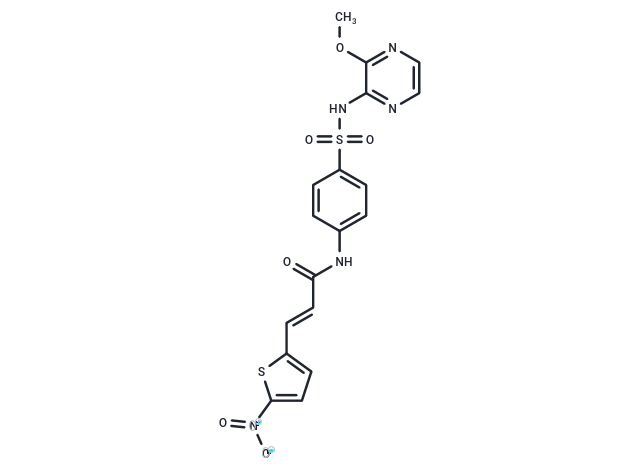Shopping Cart
- Remove All
 Your shopping cart is currently empty
Your shopping cart is currently empty

(E)-Necrosulfonamide ((E)-Necrosulfonamide) is an inhibitor of necroptosis. Blocks mixed lineage kinase domain-like protein (MLKL), a critical substrate of receptor-interacting serine-threonine kinase 3 (RIP3) during necrosis. Prevents MLKL-RIP1-RIP3 necrosome complex from interacting with downstream necrosis effectors. Binds and inhibits gasdermin D. Inhibits pyroptosis.

| Pack Size | Price | Availability | Quantity |
|---|---|---|---|
| 5 mg | $52 | In Stock | |
| 10 mg | $68 | In Stock | |
| 25 mg | $143 | In Stock | |
| 50 mg | $225 | In Stock | |
| 100 mg | $396 | In Stock | |
| 500 mg | $943 | In Stock | |
| 1 mL x 10 mM (in DMSO) | $52 | In Stock |
| Description | (E)-Necrosulfonamide ((E)-Necrosulfonamide) is an inhibitor of necroptosis. Blocks mixed lineage kinase domain-like protein (MLKL), a critical substrate of receptor-interacting serine-threonine kinase 3 (RIP3) during necrosis. Prevents MLKL-RIP1-RIP3 necrosome complex from interacting with downstream necrosis effectors. Binds and inhibits gasdermin D. Inhibits pyroptosis. |
| In vitro | Necrosulfonamide inhibits MLKL-mediated Necrosis by blocking its N-terminal CC domain function. It blocks necrosis downstream of RIP3 activation. Necrosulfonamide has no effect on apoptosis induced by TNF-α plus Smac mimetic in non-RIP3-expressing Panc-1 cells, even at 5 μM concentration. Necrosulfonamide efficiently blocks necrosis in human cells, but not mouse cells. The reason for the species specificity of necrosulfonamide is that the cysteine at residue 86 in human MLKL that is covalently modified by necrosulfonamide is replaced by a tryptophan residue in mouse MLKL(mixed lineage kinase domain-like protein)[2]. |
| Kinase Assay | PRMT Biochemical Assays: A scintillation proximity assay (SPA) is used for assessing the effect of test compounds on inhibiting the methyl transfer reaction catalyzed by PRMTs. In brief, the tritiated S-adenosyl-L-methionine (3H-SAM) is used as the donor of methyl group. The (3H) methylated biotin labeled peptide is captured in a streptavidin/scintillant-coated microplate, which brings the incorporated 3H-methyl and the scintillant to close proximity resulting in light emission that is quantified by tracing the radioactivity signal (counts per minute) as measured by a TopCount NXT Microplate Scintillation and Luminescence Counter. When necessary, nontritiated SAM is used to supplement the reactions. The IC50 values are determined under balanced conditions at Km concentrations of both substrate and cofactor by titration of test compounds in the reaction mixture. |
| Cell Research | Necrosis inhibitors induce diverse effects on MLKL phosphorylation. HT-29 cells are treated with T/S/Z with or without necrosis inhibitors for 12 hr or 8 hr. The number of dead cells is determined by measuring released protease activity in culture medium. The whole-cell extracts are prepared and analyzed by western blotting. The final concentrations of 10 μM necrostatin-1 or 1 μM necrosulfonamide are used to block necrosis. (Only for Reference) |
| Alias | (E)-Necrosulfonamide |
| Molecular Weight | 461.47 |
| Formula | C18H15N5O6S2 |
| Cas No. | 1360614-48-7 |
| Smiles | COc1nccnc1NS(=O)(=O)c1ccc(NC(=O)\C=C\c2ccc(s2)[N+]([O-])=O)cc1 |
| Relative Density. | 1.578 g/cm3 (Predicted) |
| Storage | Powder: -20°C for 3 years | In solvent: -80°C for 1 year | Shipping with blue ice. | ||||||||||||||||||||||||||||||
| Solubility Information | DMSO: 45 mg/mL (97.51 mM), Sonication is recommended. | ||||||||||||||||||||||||||||||
Solution Preparation Table | |||||||||||||||||||||||||||||||
DMSO
| |||||||||||||||||||||||||||||||

Copyright © 2015-2025 TargetMol Chemicals Inc. All Rights Reserved.